Welcome to the enchanting world of botanical witchery! Today, we’re diving into the mystical world of witch’s gardens. Whether you’re a seasoned witch, a plant lover, or just curious about adding a touch of magic to your garden, this post is for you. We’re exploring the top 5 plants that are not just beautiful but are steeped in folklore, mystery, and, of course, a dash of magic.
Here are 5 of my favorite plants to consistently grow and use in my magical practice.
5. Lavender: The Soothing Sorceress
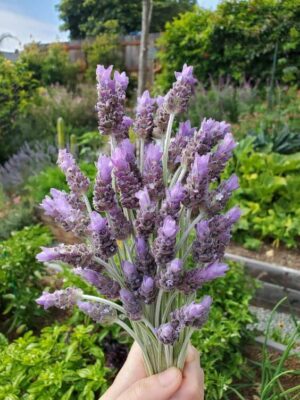
History and Folklore
Lavender, with its enchanting fragrance and delicate purple blooms, has been a cherished plant in both the culinary and magical worlds. Its name is derived from the Latin ‘lavare’, meaning ‘to wash,’ a nod to its use in baths to purify the body and spirit. Historically, it’s been a symbol of love, used to attract suitors or to send messages of adoration. In witchcraft, it’s believed to ward off evil spirits and negative energies, making it a protective herb in many rituals.
Witches of old were known to use lavender in healing spells and in love sachets, believing it to draw romantic interests. In some traditions, hanging lavender over a doorway is thought to ensure a peaceful home, and placing it under a pillow is said to promote restful sleep and pleasant dreams.
Magical Uses
In magic, lavender is a powerhouse. It’s perfect for spells related to calming anxiety, promoting peaceful sleep, and fostering love and protection. Here are a few specific ways you can use lavender in your magical practice:
Peace and Purification: Burn dried lavender or use its essential oil in cleansing rituals to purify your home and bring tranquility.
Love Spells: Carry a sachet of dried lavender or sprinkle its petals around a candle during love rituals to attract romance or strengthen existing relationships.
Sleep and Dreams: Place lavender under your pillow to encourage restful sleep and to recall dreams. It’s said to also ward off nightmares.
Protection: Create a protective charm by combining lavender with other protective herbs like sage and hang it above your front door.
As you can see, lavender has a lot of uses. This is one of my favorite herbs to grow because it’s so versatile, and can be used for pretty much any positive magical need (things you want to attract rather than banish).
Growing Tips
Lavender needs super well-draining soil, so amend potting soil with small rocks. Consider using sandy or gravelly soil to improve drainage if your soil is heavy or clay-like. Be cautious not to overwater. Lavender prefers drier conditions, so water it once the soil is dry to the touch. Lavender loves the sun, so plant it in a spot that gets at least 6 hours of direct sunlight daily. It’s a great plant to grow during the summer, but it won’t often survive a cold winter.
Typically, I grow lavender in the summer, then harvest and dry the plant for my magical purposes. However, you can also grow lavender indoors, it’s just a bit finicky and needs a lot of sunlight. Try adding a grow lamp if natural sunlight isn’t enough. You can also try growing lavender hydroponically – it’s possible, but lavender doesn’t like a lot of water, so it’ll take some skill.
4. Sage: The Protector
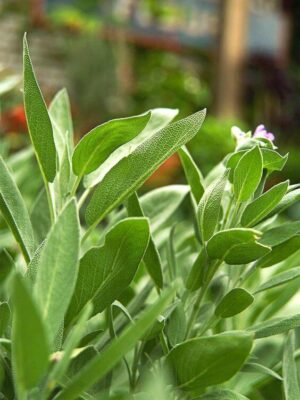
History and Folklore
Sage, with its silvery-green leaves and purifying scent, is known as both a culinary and magical herb. Known scientifically as Salvia officinalis, its name derives from the Latin “salvere,” meaning “to save” or “to heal.” This connection highlights its long-standing association with healing, protection, and wisdom. In various cultures, sage has been a symbol of longevity and wisdom, and it was often used in rituals for cleansing and protection.
In the world of witchcraft, sage is particularly renowned for its ability to cleanse spaces of negative energies. It’s common in smudging ceremonies, where the burning of sage is believed to purify and sanctify a space. This herb is also thought to enhance wisdom and mental clarity, making it a favorite for spells related to decision-making and insight.
Magical Uses
Sage’s magical properties make it a staple in any witch’s garden. Here are some ways it can be used:
Cleansing and Protection: Burning sage, or smudging, is a traditional way to cleanse a space, an object, or a person of negative energies. It’s often done before rituals to create a purified space.
Wisdom and Mental Clarity: Carrying sage or placing it on an altar can promote wisdom and clear thinking, especially in situations requiring insight and discernment.
Healing Rituals: Sage is known for its healing properties. Use it in spells or potions for wellness and to promote a speedy recovery from ailments.
Spiritual Growth: Incorporate sage into rituals or meditations focused on personal growth and spiritual awakening.
Growing Tips
Growing sage is straightforward, and it can thrive both indoors and outdoors with the right care. Sage loves sunlight, so ensure it gets at least 6-8 hours of direct sunlight daily. Make sure to use well-draining soil – nothing heavy or clay-like. However, my sage grows fine in regular garden soil. It will overwinter well and come back the next year, or you can also grow sage hydroponically. I haven’t attempted to grow sage in soil indoors, but I would imagine it’d be fine as long as you have enough sunlight.
3. Rosemary: The Remembrancer
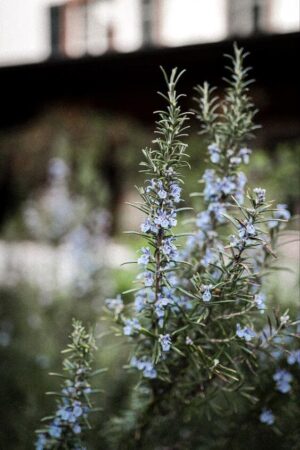
History and Folklore
Scientifically known as Rosmarinus officinalis, rosemary’s name is believed to have been derived from the Latin words “ros” (dew) and “marinus” (sea), suggesting its affinity for misty, seaside environments.
Historically, rosemary has been associated with memory and remembrance. In ancient times, it was used at weddings to symbolize loyalty and remembrance, and it was often worn by mourners at funerals as a sign of remembering the departed. In magical practices, it’s believed to enhance memory and clarity of thought, making it a popular herb for students and scholars.
Magical Uses
Rosemary is versatile in magic. Here are some of its primary uses:
Memory and Concentration: Rosemary is known to enhance memory and concentration. Keep a sprig on your desk or use it in a memory-enhancing spell.
Protection and Purification: Just like sage, rosemary can be used for protection and purification. Burn it as incense or hang dried sprigs around your home to dispel negativity and purify the space.
Loyalty and Love: Incorporate rosemary in love spells to foster loyalty and deepen emotional connections.
Dream Work: Place rosemary under your pillow to ward off bad dreams and to remember your dreams more clearly.
Rosemary is often used as a powerful catch-all herb to supercharge a spell.
Growing Tips
Rosemary is a woody evergreen. I like to grow it outdoors because it’s very hardy. You can grow rosemary indoors, but you’re best off using soil (not hydroponics) and providing it with plenty of sunlight. Rosemary doesn’t like to be too wet. You can also choose to grow this plant outdoors in pots during the summer, and harvest/dry the herb for magical uses, then bring the pot inside during the winter.
2. Mugwort: The Dream Weaver
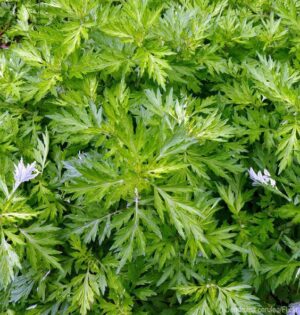
History and Folklore
Mugwort is a mystical plant, often associated with dreams and psychic abilities. It has a long history in witchcraft as a bridge between the physical and spiritual worlds. This herb, with its silvery-green leaves and modest flowers, is steeped in ancient lore and magic. Its name is thought to derive from the Greek goddess Artemis, a patron of women, which reflects its historical use in women’s health.
In folklore, mugwort is often associated with the moon, dreams, and psychic abilities. It was believed to protect travelers on their journeys and to ward off evil spirits. In medieval times, it was used to repel witches, ironically enough, yet it became a staple in many magical practices for its visionary and dream-inducing properties.
Magical Uses
Mugwort is excellent for divination, enhancing psychic abilities, and promoting prophetic dreams. Here are some of its most common uses in witchcraft:
Dreams and Psychic Work: Mugwort is renowned for its ability to induce vivid dreams and enhance psychic abilities. Place it under your pillow to promote prophetic dreams or use it in a tea before divination practices.
Protection: Carry mugwort with you or hang it around your home for protection against negative energies and spirits.
Astral Projection and Meditation: Incorporate mugwort into rituals or meditation practices aimed at astral projection or deepening your meditative state.
Healing: Mugwort is also used in healing rituals, particularly those related to women’s health, given its historical use in this realm.
Growing Tips
Mugwort isn’t particularly fussy about sunlight or soil. It grows well in full sun to partial shade and can tolerate a range of soil types. It’s also quite drought-tolerant once established. Because this herb is a perennial, I recommend growing outside and harvesting during the warmer months. It’s a wonderful addition to a night garden with its silver-green leaves.
1. Thyme: The Courageous
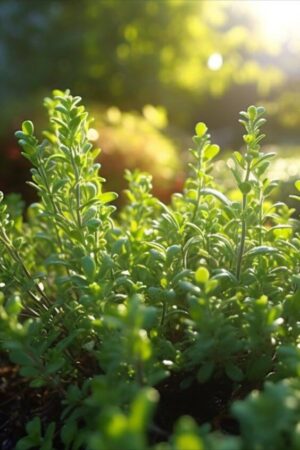
History and Folklore
Thyme, a small yet mighty herb with a big history, is known for its aromatic leaves and tiny, purple flowers. Scientifically referred to as Thymus vulgaris, thyme has been a symbol of courage and bravery since ancient times. In medieval Europe, knights would often wear sprigs of thyme as a sign of courage before going into battle. This herb also has a longstanding association with health, being used historically in various medicinal practices.
In the realm of magic, thyme is treasured for its ability to instill courage, strength, and boldness. It’s believed to imbue a sense of bravery in challenging situations and is often used in spells to empower and embolden.
Magical Uses
Thyme’s energy makes it a valuable herb in many magical practices. Here are some ways you can use thyme:
Courage and Bravery: Use thyme in spells when you need an extra boost of confidence or strength, especially in daunting situations.
Purification and Healing: Thyme can be used in purification rituals. It’s also believed to aid in healing, both physically and emotionally.
Attracting Positive Energy: Place thyme around your home to attract positive energy and to promote a peaceful environment.
Empowerment Spells: Add thyme to spells and charms when you’re seeking to enhance your personal power or when undertaking new ventures.
Because thyme adds an element of boldness, you can use it to supercharge any spell.
Growing Tips
Thyme is a versatile and easy-to-grow herb. It grows best in full sunlight and prefers well-draining soil. Thyme grows perfectly well in my herb garden each summer – I usually harvest during the summer and dry for use during the year. You can also grow thyme hydroponically quite easily.
And there you have it – the top 5 plants for your witch’s garden! Remember, planting and nurturing these herbs connects you to a rich history of folklore and magic. Whether you’re crafting spells, seeking spiritual growth, or simply enjoying their beauty and fragrance, these plants add a touch of magic to any garden. Happy planting, and may your garden bloom with magic and wonder!


